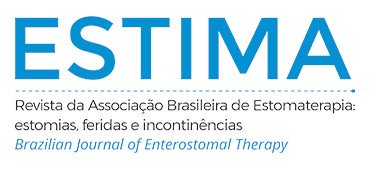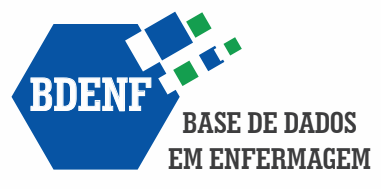BIOSOCIODEMOGRAPHIC AND DIGITAL PROFILE OF PARTICIPANTS IN AN ONLINE EDUCATIONAL INTERVENTION ON COLOSTOMY
Abstract
Objective: To identify the biosociodemographic and digital profile of people with colostomy and caregivers who participated in the online educational intervention on colostomy. Method: Cross-sectional study carried out with 20 people with colostomy and 32 caregivers, in the period of September/November 2020, in an integrated health center in Teresina, Piauí, Brazil. Sociodemographic and clinical characterization instruments, computer and internet access, and basic digital proficiency submitted to statistical analysis were used. Results: Among people with colostomy and caregivers, 60% were male and 75% female. Temporary colostomy (55%) with bright red color and regular shape (80%) predominated. Most caregivers had a job (46.9%), and 8 hours/week were dedicated to care. The degree of digital proficiency was low (76.9%). Conclusion: The identification ofthe biosociodemographic and digital profile of the participants can contribute to the adoption of educational strategies according to digital maturity or the need for support for the use of technologies, to optimize health care and qualify the assistance provided.
Downloads
Metrics
References
REFERÊNCIAS
Cerqueira LCN, Cacholi SAB, Nascimento VS, Koeppe GBO, Torres VCP, Oliveira PP. Clinical and sociodemographic characterization of ostomized patients treated at a referral center. Rev Rene. 2020; 21: e42145. https://doi.org/10.15253/2175-6783.20202142145
Brasil. Ministério da Saúde. Guia de Atenção à Saúde da Pessoa com Estomia [Internet]. Brasília: Secretaria de Atenção Especializada em Saúde; 2019. [cited 2020 Apr 06]. Available from: https://www.saude.gov.br/images/pdf/2019/julho/26/GUIA-ESTOMIA-Consulta-Publica-05-06-2019.pdf
Diniz IV, Barra IP, Silva MA, Oliveira SHS, Mendonça AEO, Soares MJGO. Perfil epidemiológico de pessoas com estomias intestinais de um centro de referência ESTIMA, Braz. J. Enterostomal Ther. 2020, 18: e2620. https://doi.org/10.30886/estima.v18.929_P
Beaubrun En Famille Diant L, Sordes F, Chaubard T. Psychological impact of ostomy on the quality of life of colorectal cancer patients: Role of body image, self-esteem and anxiety]. Bull Cancer. 2018;105(6):573-580. https://doi.org/10.1016/j.bulcan.2018.03.005.
Maurício Vanessa Cristina, Souza Norma Valéria Dantas de Oliveira, Costa Carolina Cabral Pereira da, Dias Midian Oliveira. The view of nurses about educational practices targeted at people with a stoma. Esc Anna Nery. 2017; 21 (4): e20170003. https://doi.org/10.1590/2177-9465-ean-2017-0003.
David JG, Moreno S, Daniel R, Pall H. The Perceived Ostomy Educational Needs of Pediatric Patients With Inflammatory Bowel Disease and Their Caregivers. J Pediatr Gastroenterol Nutr. 2020;70(6):849-852. https://doi.org/10.1097/MPG.0000000000002665
Pittman J, Nichols T, Rawl SM. Evaluation of Web-Based Ostomy Patient Support Resources. J Wound Ostomy Continence Nurs. 2017;44(6):550-556. https://doi.org/10.1097/WON.0000000000000371.
Newman K, Wang AH, Wang AZY, Hanna D. The role of internet-based digital tools in reducing social isolation and addressing support needs among informal caregivers: a scoping review. BMC Public Health. 2019; 19 (1495): 2-12. https://doi.org/10.1186/s12889-019-7837-3.
Instituto Brasileiro de Geografia e Estatística (BR). Acesso à Internet e à televisão e posse de telefone móvel celular para uso pessoal: 2017 [Internet]. 2018 [cited 2020 Nov 12]. Available from: https://biblioteca.ibge.gov.br/index.php/biblioteca-catalogo?view=detalhes&id=2101631.
Monteiro AKC, Mendes IAC, Pereira MCC, Gouveia MTO, Andrade JX, Andrade, EMLR. Contribuição de educação permanente semipresencial no conhecimento de enfermeiros sobre estomias intestinais de eliminação. Rev Min Enferm. 2019; 23: e-1177. https://doi.org/10.5935/1415-2762.20190025.
Jimenez YA, Wang W, Stuart K, Cumming S, Thwaites D, Lewis S. Breast Cancer Patients' Perceptions of a Virtual Learning Environment for Pretreatment Education. J Cancer Educ. 2018; 33(5):983-990. https://doi.org/10.1007/s13187-017-1183-x.
Shin JY, Choi SW. Online interventions geared toward increasing resilience and reducing distress in family caregivers. Curr Opin Support Palliat Care. 2020 Mar;14(1):60-66 https://doi.org/10.1097/SPC.0000000000000481.
Marques Junior E, Oliveira Neto JD, Marques EMR. PROFIX: método de avaliação on-line da proficiência digital. Paidéia 2014; 6 (10):1-25.
Silva CRDT, Andrade EMLR, Luz MHBA, Andrade JX, Silva GRF. Quality of life of people with intestinal stomas. Acta Paul. Enferm. 2017; 30 ( 2 ): 144-151. https://doi.org/ 10.1590/1982-0194201700023
Bonill-de las Nieves C, CC, Celdrán-Mañas M, Morales-Asencio JM, Hernández-Zambrano SM, Hueso-Montoro C. Ostomy patients’ perception of the health care received. Rev. Latino-Am. Enfermagem. 2017;25:e2961. https://doi.org/10.1590/1518-8345.2059.2961.
Brigstock H. Implementation of a peer-facilitated new ostomy patient workshop. In: TH ANNUAL CONFERENCE, 49., 2017, Utah. Anais [...]. Utah: University of San Francisco, 2017.
Yuan JM, Zhang JE, Zheng MC, Bu XQ. Stigma and its influencing factors among Chinese patients with stoma. Psychooncology. 2018;27(6):1565-1571. https://doi.org/10.1002/pon.4695.
Lira JAC, Bezerra SMG, Oliveira AC, Rocha DM, Silva JS, Nogueira LTN. Collection and Adjuvant Equipment Costs in Patients with Elimination Ostomy. Rev Min Enferm. 2019 ;23:e-1163. https://doi.org/10.5935/1415-2762.20190011.
Morais FF, Santos JDM, Vera SO, Oliveira RGA, Andrade EMR, Auaújo SNMA. Management of intestinal stomas: knowledge of the caregiver. O Mundo da Saúde 2018; 42(4): 823-844. https://doi.org/10.15343/0104-7809.20184204823844.
Muzira A, Kakembo N, Kisa P, Langer M, Sekabira J, Ozgediz D, Fitzgerald TN. The socioeconomic impact of a pediatric ostomy in Uganda: a pilot study. Pediatr Surg Int. 2018;34(4):457-466. https://doi.org/10.1007/s00383-018-4230-8.
Berti-Hearn L, Elliott B. Colostomy Care: A Guide for Home Care Clinicians. Home Healthc Now. 2019;37(2):68-78. https://doi.org/10.1097/NHH.0000000000000735.
Schooley B, Singh A, Hikmet N, Brookshire R, Patel N. Integrated Digital Patient Education at the Bedside for Patients with Chronic Conditions: Observational Study. JMIR mHealth and uHealth.2020, 8 (12), e22947. https://doi.org/10.2196/22947
Downloads
Published
How to Cite
Issue
Section
License
Copyright (c) 2023 Ana Karine da Costa Monteiro, Ana Karoline da Costa Monteiro, Raissa Souza Matias , Yarla Brena Araújo de Sousa Brasileiro, Márcia Teles de Oliveira Gouveia , Augusto Cezar Antunes de Araujo Filho, Elaine Maria Leite Rangel Andrade

This work is licensed under a Creative Commons Attribution 4.0 International License.

























